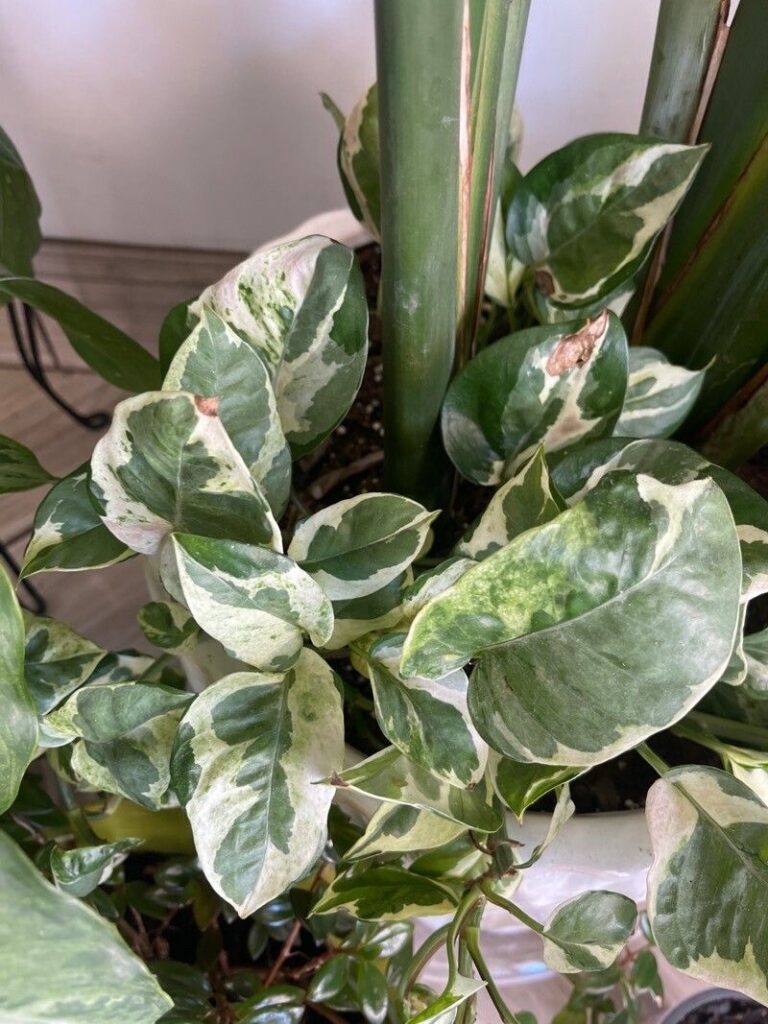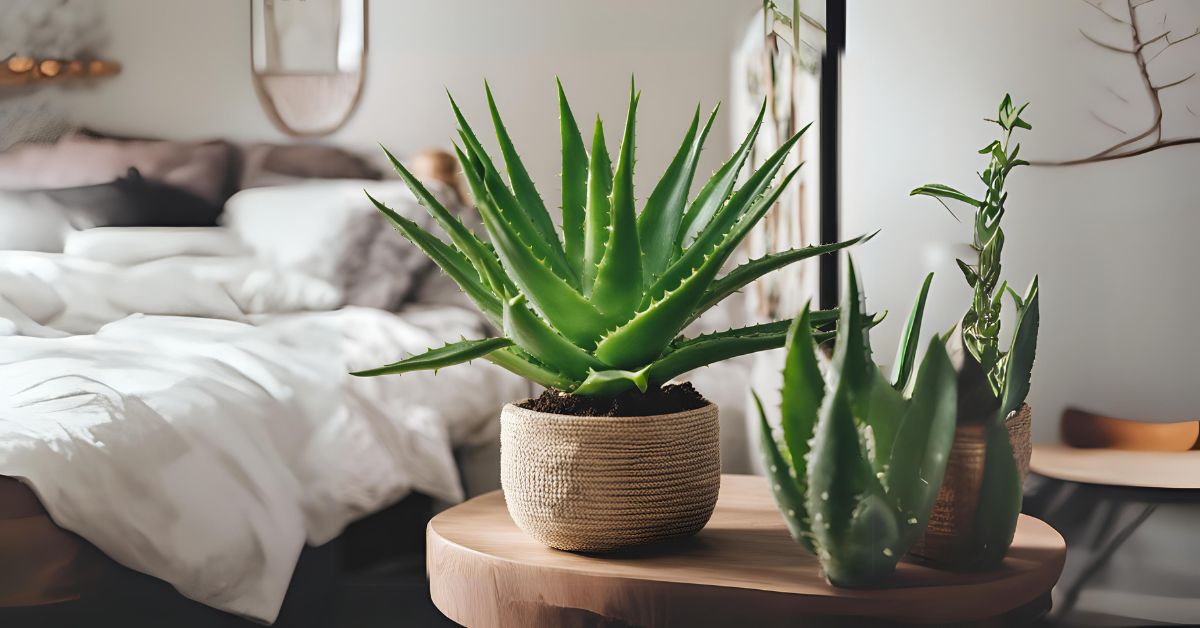- What is a Pothos Plant?
- Pothos Plant Benefits
- What makes Pothos Special?
- Where to place your Pothos Plant?
- Pothos Plant specifications
- Pothos Plant Types and Varieties
- Marble Queen Pothos (Epipremnum aureum ‘Marble Queen’)
- Manjula Pothos (Epipremnum aureum ‘Manjula’)
- Neon Pothos (Epipremnum aureum ‘Neon’)
- Golden Pothos (Epipremnum aureum)
- Jessenia Pothos (Epipremnum aureum ‘Jessenia’)
- Pearls and Jade Pothos (Epipremnum aureum ‘Pearls and Jade’)
- N’Joy Pothos (Epipremnum aureum ‘N’Joy’)
- Cebu Blue Pothos (Epiprem aureum ‘Cebu Blue’)
- Snow Queen Pothos (Epipremnum aureum ‘Snow Queen’)
- Pothos Plant Care and Maintenance
- Pothos Plant Propagation
- Plant Problems in Pothos Plant
- Diseases in Pothos Plant
- Common Misconceptions about Pothos
- Final Thought and Personal View
What is a Pothos Plant?
Pothos (Epipremnum aureum), also known as Devel’s Ivy and Money Plant, is a wonder plant that can survive in thickest conditions. These climbing champions use their aerial roots to absorb moisture and nutrition from the air, which makes them highly adaptable.
Pothos is considered to bring wealth and prosperity. They make perfect indoor plants because of their natural air purifier qualities. There are studies that have proven that pothos helps remove harmful chemicals like benzene and formaldehyde from the surrounding air.
Pothos plant Benefits
Pothos plants provide a wide range of advantages and applications. They may enhance your living environment, improve indoor air quality, stimulate emotions of well-being, and even have symbolic importance.
- Purifies Air
- Easy to Maintain
- Reduces Stress
◼Purifies Air
Pothos plants are great at eliminating typical home pollutants from the air. They can efficiently filter out formaldehyde, benzene, xylene, and other toxins, resulting in a cleaner interior atmosphere.
Hence, they should be effective in areas such as kitchens, bathrooms, and laundry rooms.
◼Easy to Maintain
The pothos’ compact size and attractive foliage make it easy to care for, and because of this, it makes it an ideal houseplant to manage. Like other low-maintenance indoor plants, they grow well in environments with moderate to low light levels and don’t require frequent watering.
Their drooping leaves frequently serve as a helpful signal when they need water, making them excellent for forgetful plant parents.
◼Reduces Stress
What makes Pothos Special?
Pothos plants have distinctive aerial roots that emerge from the stems. In their native environment, these roots assist them in climbing trees and other structures for support and sunlight.
While aerial roots are not required for indoor growth, they can provide a unique textural aspect.
Where to place your Pothos Plant?
◼Flow of Positive Energy
◼For Optimal Growth
◼Clarity and Peace
◼New Beginnings
Pothos Plant specifications
| Botanical Name | 🌱 Epipremnum aureum 🌱 |
|---|---|
| Color |
|
| Size |
Varies:
|
| Origin | Southeast Asia, including the Solomon Islands, French Polynesia, and parts of India. |
| Flowering |
|
| Pattern | Green; variegated variants include Marble Queen, Manjula, Neon, and Golden Pothos |
| Planting Season |
|
Pothos Plant Types and Varieties
◼Marble Queen Pothos (Epipremnum aureum 'Marble Queen')
◼Manjula Pothos (Epipremnum aureum 'Manjula')
◼Neon Pothos (Epipremnum aureum 'Neon')

◼Golden Pothos (Epipremnum aureum)

◼Jessenia Pothos (Epipremnum aureum 'Jessenia')
◼Pearls and Jade Pothos (Epipremnum aureum 'Pearls and Jade')
◼N'Joy Pothos (Epipremnum aureum 'N'Joy')
◼Snow Queen Pothos (Epipremnum aureum 'Snow Queen')
Pothos Plant Care and Maintenance
Here’s a full guide on care for your pothos plant all year:
◼Lighting and Placement
For Spring and Summer:
Pothos prefers bright, indirect sunshine. An east-facing window with morning sunlight is good. South-facing windows may require some shielding from intense afternoon light. You may determine their light requirements by examining their development. Watch for leggy growth, it means the plant is receiving insufficient light.
For Fall and Winter:
As natural light fades away, move the plant closer to a window to optimize available light. Also, supplement with grow lights placed a few inches above the plant for 10-12 hours each day.
◼Watering
For Spring and Summer:
Water your pothos when the top inch or two of the soil is dry to the touch. Water thoroughly until the excess water drains out of the drainage holes. Remember, it is better to underwater your pothos plant than to overwater it.
For Fall and Winter:
Reduce watering when the plant enters semi-dormancy. Watering every two to three weeks may be adequate, but modify the frequency according to soil dryness. Feel the top inch of soil; if it’s damp, avoid watering.
◼Temperature
Pothos enjoy typical room temperatures of 65°F to 75°F (18°C – 24°C). Avoid exposing them to chilly breezes and frost.
◼Humidity
Pothos prefer moderate humidity levels (around 40-50%). They can withstand lower or slightly higher humidity levels, but extremes can be problematic.
To enhance humidity somewhat, use a pebble tray filled with water, but don’t submerge the pot. Grouping your pothos with other plants that thrive in dampness might also assist.
◼Fertilizer
A gentle feeding throughout the growing season (spring and summer) using a balanced liquid fertilizer diluted to half strength is adequate. Avoid over-fertilization, which might result in discolored leaf tips. You can fertilize once a month at this time.
Do note that in fall and winter, fertilize less regularly, possibly once every 2-3 months, or skip altogether depending on the plant’s development.
◼Repotting
Repot your pothos only after the roots have outgrown the pot and become pot-bound. Signs include roots around the container or pushing up through the dirt. In general practice, repotting is usually carried out every 2-3 years.
◼Soil
Choose a well-draining potting mix for the pothos plant. A commercial cactus or succulent mix works well, but you can make your own by combining potting soil, perlite, and, if desired, orchid bark or coco coir for additional drainage.
◼Cleaning
Pothos plants do not require substantial cleaning. To eliminate dust from the leaves, wipe them down every now and then with a moist towel. Avoid using strong chemicals or leaf-shine treatments.
◼Pruning
Pruning is optional, although it can assist in maintaining a neat appearance and promote new growth. You can trim discolored or damaged leaves and clip leggy stems. Pruning can be performed at any time of year.
Pothos Plant Propagation
It is really easy to propagate Pothos! Here are two methods:
◼By dividing
During repotting, gently separate healthy clumps of the plant’s roots to form new pothos plants.
◼By leaf cutting
Pothos is one of the most easily propagated plants. Simply cut a stem in water or damp soil. New roots will develop quickly, allowing you to grow additional plants for yourself or share with others.
Plant Problems in Pothos Plant
While pothos has a reputation for easy-to-care plants, they might have some problems if the needs still need to be addressed. Here’s an overview of the most frequent pothos issues and how to solve them:
◼Slow Growth or Leggy Appearance
Insufficient light can result in poor growth and stretched-out or leggy leaves that lose their brilliant color. Move your pothos to a spot that receives more indirect sunlight. Avoid intense, direct sunlight, since it can burn the foliage.
◼Yellow or Droopy Leaves
Overwatering is most likely the cause of the problem. To avoid the problem, don’t water the plants on a schedule, but water when it is needed. Watering when the top inch of the plant soil is dry is the best method.
◼Root Rot
Similar to the yellow and droopy leaves issue, overwatering could be the culprit causing the root rot. Rot can be avoided. Always maintain good drainage so that excess water escapes the pot.
Ensure that there is no water settling at the bottom of the pot, especially when you are using the plates below the pot. Throw out the excess settled water in plates, if any.
◼Brown Leaf Tips
Dry air during low humidity can lead to brown leaf tips. Combine your pothos with other humidity-loving plants, or use a pebble tray filled with water to boost humidity levels somewhat. Make sure that the pot is not sitting in water.
Diseases in Pothos Plant
◼Mealybugs or Scale Insect Attack
Pothos can be infested by Mealybugs or Scale Insects, however, this is uncommon. In case of an infection, firstly, separate this plant from others and spray neem oil. You can alternatively use the insecticidal soap and water mix to clean the affected areas.
◼Fungal Infection
There is little chance of Pothos getting a fungal infection, but if infected, remove the infected leaves immediately. Ensure that the air circulation around the plant is sufficient and that it is not placed in a crowded corner. Use the fungicides if improvements are not seen.
Common Misconceptions about Pothos
Many people believe that pothos plants are highly toxic, and can cause damage to humans and pets if ingested. Although pothos plants do contain calcium oxalate crystals, which may lead to slight irritation if consumed, they are not highly toxic.
Eating small portions of pothos leaves or stems usually just causes slight discomfort, like mouth irritation or feeling queasy. While severe effects from consuming pothos are uncommon, the plant is generally safe to keep in households with kids and pets, as long as you’re careful to avoid ingestion.
Final Thought and Personal View
The benefits of pothos plants exceed the drawbacks. They’re an excellent choice for both new and experienced plant parents, because of their low maintenance requirements, air-purifying qualities, and stunning leaves.
Every plant has its pros and cons, so just keep their minor toxicity in mind if you have pets or small children, and avoid growing them outside in warm climates unless you have a controlled setting.















